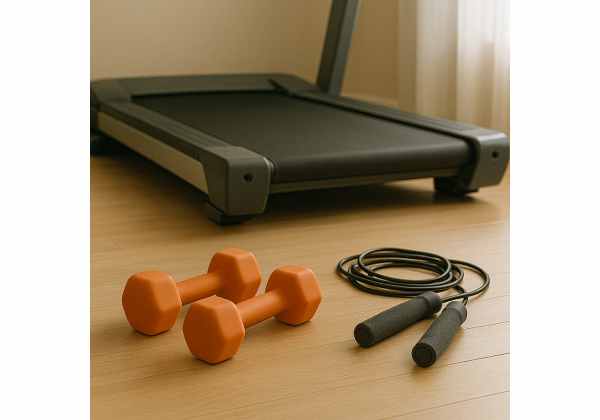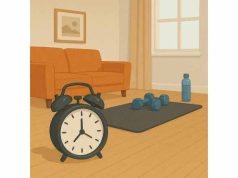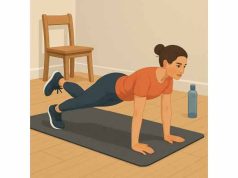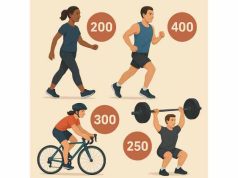
Choosing between high-intensity intervals (HIIT) and steady-state cardio can feel like a coin toss. Both can help you lose body fat, but they do it in different ways and place different demands on your time, joints, and recovery. This guide explains how each method works, who tends to benefit most, and how to combine them for steady progress without burnout. You will get sample workouts, weekly templates, and troubleshooting steps grounded in practical programming—not hype. For the broader framework that blends strength, cardio, and daily movement into a cohesive plan, see our overview of exercise for fat loss and then use the templates below to tailor your cardio mix.
Table of Contents
- Does HIIT burn more fat?
- Steady-state benefits
- How to choose your mix
- Sample HIIT workouts
- Steady-state templates and progressions
- Common mistakes and fixes
- Safety, recovery and nutrition
- Frequently Asked Questions
Does HIIT burn more fat?
HIIT alternates short bursts of near-maximal effort with recovery intervals. The appeal is clear: it is time-efficient, it feels purposeful, and it improves fitness quickly. You will often read that HIIT “torches fat,” largely because of higher per-minute energy cost and a small, temporary increase in post-exercise oxygen use (EPOC). Those effects are real—but they are modest compared with the total picture of weekly activity and diet.
Here is what the balance of evidence and coaching practice suggest:
- Time efficiency: HIIT compresses work into short sessions. If your schedule is tight, 10–25 minutes of structured intervals can match the calorie burn of a longer easy session, especially as your conditioning improves.
- Fitness transfer: Intervals raise your ceiling—VO₂max, power, and speed. A higher engine lets you do more total work in future sessions, which indirectly supports fat loss.
- Appetite and recovery: Very hard intervals can spike fatigue and hunger in some people. If that leads to extra snacking or skipped strength sessions, your weekly deficit shrinks.
- Injury risk: Rapid efforts and impact magnify minor technique issues. Choose low-impact modes (bike, rower, elliptical) if your joints are sensitive.
What about steady-state? When programs are matched for total work and calories, fat loss over weeks is similar. The better choice depends on your preference, goals, and recovery bandwidth. Many people do best with one to two HIIT days a week and additional easy cardio and steps to raise weekly energy use without draining recovery.
Finally, remember the hierarchy: strength training preserves muscle, nutrition sets the deficit, and cardio fills the remaining gap. If you are re-starting or want the big rocks first, skim our concise guide to safe fat-loss fundamentals before layering intervals on top.
Steady-state benefits
Steady-state cardio is continuous, comfortable-to-moderate effort (often called Zone 2). It is simple to recover from, joint-friendly when you choose the right modality, and deceptively powerful for long-term adherence.
Why it deserves a permanent place in fat-loss plans:
- Low stress, high repeatability. Easy effort lets you rack up minutes—and therefore calories—day after day without wrecking your legs for strength sessions.
- Appetite stability. Many notice fewer hunger spikes after easy sessions compared with very hard intervals, which can make sticking to a calorie target easier.
- Aerobic base. Building your base improves fat oxidation at a given workload and raises the ceiling for future interval quality.
- Movement skill. Steady work is a safe place to refine technique—stride rhythm, cadence, breathing—so higher-intensity work later feels smoother.
Practical guidelines:
- Use nasal or conversational breathing as an intensity check; you should be able to talk in full sentences.
- Accumulate 150–300+ minutes per week depending on your goals and recovery. This includes purposeful cardio and brisk steps.
- If you want a clear primer on easy endurance—heart-rate ranges, benefits, and workouts—bookmark our overview of easy Zone 2 cardio.
Modes that shine: brisk walking outdoors or on an incline treadmill, cycling (indoor or outdoor), elliptical, and rowing at gentle paces. Keep at least one mode that is truly low impact to protect your joints as training volume climbs.
How to choose your mix
You do not need to pick a side. The winning strategy blends methods to match your schedule, training age, joint history, and preferences.
Step 1: Set non-negotiables
- Strength first: 2–3 weekly sessions to keep muscle while dieting.
- Daily movement: 6,000–10,000+ steps across the day.
- Cardio minutes: budget based on time and recovery (e.g., 90–180 minutes/week).
Step 2: Slot HIIT where it fits
- Beginners: one short interval day (10–15 min of work inside a 20–25 min session).
- Intermediates: one to two HIIT days (15–20 min of work inside 25–35 min).
- Advanced: two HIIT days if you recover well and keep easy minutes high.
Step 3: Fill the rest with steady-state
Use easy cardio and walking to hit your weekly minutes without sabotaging leg strength.
Two sample weeks
- Template A (3 strength • 2 cardio):
Mon Full-body + 10 min easy spin • Tue Steady 30–40 min • Wed Full-body • Thu HIIT 20–25 min • Sat Full-body + 15 min easy walk - Template B (2 strength • 3 cardio):
Mon Lower-body • Tue Steady 30–45 min • Thu Upper-body • Fri HIIT 20–30 min • Sun Steady 30–40 min
When life is busy, short intervals shine. For plug-and-play sessions that fit a lunch break, see our 20-minute HIIT options.
Sample HIIT workouts
These options cover bike, rower, treadmill, and bodyweight. Warm up 5–7 minutes first (gradually increasing pace), then cool down 3–5 minutes. Choose one or two sessions per week, separated by at least 48 hours.
1) Intro intervals (RPE-based)
- 8× (30″ hard @ RPE 8 / 60″ easy) on bike or elliptical
- Total work: 8 minutes inside a 20–22 minute session
- Focus on smooth cadence and posture; stop one rep shy of form breakdown.
2) Pyramid set (low impact)
- Row or cycle: 1′ hard / 1′ easy → 2′ hard / 2′ easy → 3′ hard / 3′ easy → 2′ hard / 2′ easy → 1′ hard / 1′ easy
- Total work: 9 minutes hard inside ~25 minutes
- Keep “hard” at controlled 85–90% effort; no sprinting.
3) Treadmill speed play (for runners)
- 10× (60″ strong / 60″ easy jog or walk)
- Start at a pace that is “5K-effort,” not all-out. Increase by 0.1–0.2 mph only if form stays crisp.
4) Bodyweight EMOM (home, no equipment)
- 12 minutes EMOM (every minute on the minute): Minute 1—Squat jumps ×8–12; Minute 2—Alternating reverse lunge ×12; Minute 3—Hands-elevated push-ups ×8–12.
- Keep landings quiet; switch to non-jump variations if knees object.
Progression rules
- Add one rep per interval, one round, or 5–10 seconds to hard segments before increasing speed or resistance.
- Cap total hard work at 15–20 minutes per session for most.
For more fast, structured options that pair well with strength days, see our concise 30-minute fat-burning templates.
Steady-state templates and progressions
The goal is accumulation: minutes at a truly comfortable pace. Keep breathing steady and posture relaxed. Progress gently so your legs stay fresh for lifting.
Walking (outdoor or treadmill)
- Baseline: 25–35 minutes brisk, 2–4% incline if indoors.
- Progression: add 5 minutes per week until you reach 45–60 minutes, or add 1% incline once pace is steady.
- If you prefer structure, our incline walking guide shows interval and hill options that stay joint-friendly.
Cycling (indoor or outdoor)
- Baseline: 30–40 minutes at 80–95 rpm, light-moderate resistance.
- Progression: add 5–10 minutes, or insert 3–4 × 3-minute “upticks” at just-harder-than-steady with equal easy spinning.
Elliptical
- Baseline: 25–35 minutes, steady cadence, hands-free when possible.
- Progression: raise resistance one notch or add 3 minutes every week. Keep motion quiet and smooth.
Rowing (technique first)
- Baseline: 6–10 rounds of 2′ easy / 1′ very easy.
- Progression: extend the easy segment to 3–4 minutes per round before you raise stroke power.
Weekly target ideas
- Two 30–45 minute steady sessions plus a longer 45–60 minute weekend walk or ride can push you into the 150–300 minute zone without feeling like a grind.
Common mistakes and fixes
Even well-intended plans can stall if stress outruns recovery or sessions drift away from their purpose. Use this checklist to stay on track.
1) Turning every workout into a race
- Fix: label days by intent—easy, interval, or lift—and stick to it. Easy should feel easy.
2) Too much HIIT, too soon
- Fix: cap at one to two interval days weekly. Add steady minutes and steps for extra burn.
3) Skipping strength work
- Fix: schedule two to three 30–45 minute strength sessions. Strength keeps muscle while the scale moves.
4) Chasing watch calories
- Fix: treat device numbers as rough. Track weekly weight averages, waist/hip measurements, performance, and adherence instead.
5) Under-recovering** (poor sleep, aches, irritability)
- Fix: add a rest day, reduce intervals by 20–30%, or swap one HIIT for steady-state. For simple scheduling guardrails, see our guide on how many rest days to take during a cut.
6) Ignoring joint feedback
- Fix: shift to low-impact modes (bike, elliptical, incline walk), shorten intervals, or lower impact height.
7) Under-fueling strength days
- Fix: place a carb-protein meal within 2–3 hours before lifting. Cardio supports the deficit; nutrition and strength protect muscle.
Safety, recovery and nutrition
Cardio should support fat loss—not derail your lifting or leave you exhausted. Anchor these basics and you will progress steadily.
Warm-up and technique
- 5–7 minutes ramping pace is enough for most. Add two short pickups before intervals. Keep posture tall, cadence smooth, and breathing rhythmic.
Progress gradually
- Increase only one variable at a time: session length, number of intervals, or resistance. Hold changes for 1–2 weeks before stacking more.
Fuel the work
- Daily protein: 1.6–2.2 g/kg body weight.
- Modest calorie deficit: typically 300–500 kcal/day for many adults.
- Pre-lift: carb + protein (e.g., yogurt and fruit). Post-session: protein + fiber-rich carbs to steady appetite.
Sleep and stress
- Aim for 7–9 hours. Poor sleep raises hunger and reduces training quality.
- Deload every 4–6 weeks: trim interval volume and keep easy cardio.
When to seek medical input
- Heart, metabolic, or orthopedic conditions; pregnancy or postpartum; dizziness during exercise; or return from injury. Start with low-impact modes and progress conservatively.
Frequently Asked Questions
Is HIIT better than steady-state for fat loss?
When weekly calories and work are matched, total fat loss is similar. HIIT is time-efficient and boosts fitness fast; steady-state is easier to recover from and sustain. Most people do best combining one to two HIIT days with additional easy cardio and steps.
How many HIIT sessions should I do per week?
Start with one weekly session. If recovery and performance stay strong, move to two. Cap total hard work at 15–20 minutes per session, separated by at least 48 hours. Fill the rest of your cardio minutes with steady-state or brisk walking.
Does HIIT build muscle like lifting?
No. HIIT improves conditioning and may maintain some leg strength, but it is not a substitute for resistance training. Keep two to three strength sessions weekly to preserve muscle while dieting, then use cardio to increase total energy expenditure.
What counts as steady-state intensity?
A conversational pace: you can speak in full sentences without gasping. On machines, keep cadence smooth and breathing steady. Outdoors, brisk walking, easy jogs, cycling, or gentle rowing qualify when the effort feels comfortably hard but sustainable.
Can beginners do HIIT safely?
Yes—if the mode is low-impact and intervals are short. Try 6–10 rounds of 20–30 seconds hard with 40–90 seconds easy on a bike or elliptical. Stop one rep shy of sloppy form. Increase volume slowly and prioritize steady-state minutes.
Will steady-state cause muscle loss?
Not when you lift regularly, eat adequate protein, and keep a modest deficit. Muscle loss is more likely from under-fueling, skipping strength work, or doing too much high-stress cardio. Balance matters more than the specific cardio mode.
What’s the best cardio for bad knees?
Choose low-impact options: cycling, elliptical, rowing, or incline walking. Keep intervals shorter, avoid deep knee angles if painful, and progress resistance slowly. If discomfort persists, consult a clinician and focus on form and strength around the hips.
References
- Effect of High-Intensity Interval Training vs. Moderate-Intensity Continuous Training on Fat Loss and Cardiorespiratory Fitness in the Young and Middle-Aged a Systematic Review and Meta-Analysis — 2023 (Systematic Review)
- Effect of exercise training on weight loss, body composition changes, and weight maintenance in adults with overweight or obesity: An overview of 12 systematic reviews and 149 studies — 2021 (Systematic Review)
- Magnitude and duration of excess of post-exercise oxygen consumption between high-intensity interval and moderate-intensity continuous exercise: A systematic review — 2021 (Systematic Review)
- WHO guidelines on physical activity and sedentary behaviour — 2020 (Guideline)
- Systematic review and meta‐analysis of protein intake to support muscle mass and function in healthy adults — 2022 (Systematic Review)
Medical Disclaimer
This article is educational and not a substitute for personalized medical advice. Consult a qualified professional before changing your exercise or nutrition plan—especially if you have cardiovascular, metabolic, or orthopedic conditions; take medications that affect heart rate or blood glucose; are pregnant or postpartum; or are returning after injury or surgery.
Share and Stay Connected
If this guide clarified how to balance HIIT and steady-state, consider sharing it with a friend and follow us on your preferred platform. Your support helps us continue producing clear, evidence-informed resources.










